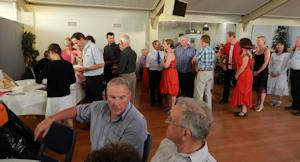Recipes - and Feasts
As you begin to create your ketogenic lifestyle, make the effort to try out a couple of new recipes each week. I'm not the cook in our family. Carolyn, my wife, seems to find it easy to whip-up something new without carbs, most days. For me, the recipe book is an essential source of great new ideas.
You need variety in your diet, and it needs to be exciting, and interesting and delicious. All those things are possible, if you learn just a little about food preparation. Search online for Keto Recipes.
If you are putting on a feast, at home, for instance, in addition to providing some of the things your guests will expect, cakes, biscuits and sandwiches, also offer two or three delicious recipes from the Banting Cookbook.
Living a Ketogenic Lifestyle for Better Health
Understanding Types of Food.
 The are three macro-nutrients, Carbohydrate, proteins and fats.
The are three macro-nutrients, Carbohydrate, proteins and fats.
Most foods contain a little of each, but are predominantly one of those.
Meats for instance, are mostly protein and fat. ![]() The protein is broken down into amino acids. The fat is mostly saturated fat, but also some mono-unsaturated fat.
The protein is broken down into amino acids. The fat is mostly saturated fat, but also some mono-unsaturated fat.
![]() Carbohydrates are easy to recognise. All sugars are carbohydrates. Honey is a carbohydrate. All flours and starchy root vegetables are carbohydrates. So bread, potatoes, rice and pasta are off the diet, if you are eating a ketogenic diet.
Carbohydrates are easy to recognise. All sugars are carbohydrates. Honey is a carbohydrate. All flours and starchy root vegetables are carbohydrates. So bread, potatoes, rice and pasta are off the diet, if you are eating a ketogenic diet.
Leafy vegetables are very much in the diet. As are most fruits in small quantities.
Butter and olive oil and coconut oil are wonderful fats that make your food taste delicious. You can also use cream, but you should avoid milk if you can.
Social Activities - and Feasts
If you take a lunch to your walking group, your lunch will stand out. No sandwiches, and no cakes. You'll have a salad, and a can of fish, with Banting seed and nut crisps, and cheese. You might drop a big lump of butter into your tea or coffee. People will notice.
If you attend a party, there will be lots of sandwiches and cakes, and some fruit cut into slices. There might also be celery and carrot cut into finger food pieces, with dip. If you are lucky there will be some kebabs, meat and vegetables, or some roast chicken pieces.
Usually, there is plenty to eat, keeping off carbohydrates. You'll find that you have no craving for the cakes and sandwiches. The fruit will be tempting, try some. Eat the available meats. If you are hungry (you probably won't be) get a cup of tea or coffee and saturate it with a chunk of butter.
Exercise
If your weight is under control, and you are getting healthier, you will want to exercise more.
Try to get engaged with other people in social activities that involve exercise. Join a sports club, or go dancing, or join a walking group. It's much more fun together.
I go dancing twice a week, walk with a group on Mondays, cycle quite a lot, and I always take the stairs rather than the lift.
![]() I've got a few suggestions, here, about exercises that I do in my garage.
I've got a few suggestions, here, about exercises that I do in my garage.
Lipophobia - Fear of Saturated Fats.
For 50 years, we've been told that low-fat is good and high-fat is dangerous. ![]() It was supposed to raise our cholesterol.
It was supposed to raise our cholesterol.
We did not understand that eating carbohydrates activates insulin, to burn or store glucose in the blood. When insulin turns off, suddenly we are hungry again, so we end up eating more carbohydrate every two hours.
In contrast, if we avoid carbohydrates and eat more fats, the fat is used for fuel, and once that is gone, the body can still burn the fat off your hips. So you don't feel hungry. Your body isn't continually switching insulin on and off. ![]() Your metabolism becomes quite stable and under your control.
Your metabolism becomes quite stable and under your control.
Critical Living Questions
As you begin this journey, there is much you need to learn about the science of foods, and about your own body.
You don't have to learn this all at once. ![]() Start the journey,
Start the journey, ![]() keep a health journal, and slowly
keep a health journal, and slowly ![]() accumulate new knowledge as you go along.
accumulate new knowledge as you go along.
There will always be a few things you remain curious about. ![]() If you are a member of a group, it's easier to get some guidance on these issues as they arise.
If you are a member of a group, it's easier to get some guidance on these issues as they arise.
LCHF Ketogenic Diet - No Hunger
If you have enough fat in your diet, you won't feel hungry. It will be possible to skip meals if you choose to do so. Many people ![]() eating a LCHF diet end up eating only twice a day.
eating a LCHF diet end up eating only twice a day.
If you are in ketosis, once you've been there for a while, ![]() your homeostasis set point will change, and you'll begin to crave different foods.
your homeostasis set point will change, and you'll begin to crave different foods.
For instance, I now crave just a little fruit. Quarter of an apple, or half a nectarine. There is no desire to eat the muffin that's on offer. A plate of vegetables with roast lamb looks delicious, and I'm not looking for desert.
When I was not quite adapted to this lifestyle, I was drinking quite a lot of saturated coffee. (Saturated coffee is black coffee, with a tablespoon of coconut oil added.) (Alternative, add a tablespoon of butter.) This can add to your weight if you over-do it. But it does get you past morning tea, without adding any carbohydrates.
Measuring Your Meals
![]() With LCHF diets, when you don't have carbohydrates on your plate, there's nothing to count.
With LCHF diets, when you don't have carbohydrates on your plate, there's nothing to count.
At least in the beginning that's all you need to know. If you are putting carbs on your plate, you need to measure how many grams of food that is, and convert that to grams of carbohydrate. There are charts and online calculators to help you do that.
![]() If weight control is all you are seeking, that's all you need to know.
If weight control is all you are seeking, that's all you need to know.
If you want to get into ketosis and stay there, you might need to learn more about ![]() the protein and fats in your diet, and there are tools to teach you that.
the protein and fats in your diet, and there are tools to teach you that.
